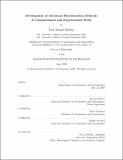Development of Astronaut Reorientation Methods: A Computational and Experimental Study
Author(s)
Stirling, Leia Abigail
DownloadACDL_TR-08-5.pdf (4.775Mb)
Metadata
Show full item recordAbstract
Past spaceflight missions have shown that astronauts adapt their motor-control strategies to the microgravity environment. Even though astronauts undergo hundreds of training hours, the strategies for locomotion and orientation are not specifically prescribed. The majority of an astronaut’s motion-control strategies are developed underwater. While underwater training can be beneficial in certain aspects, such as learning which orientations an astronaut will encounter and becoming familiar with task timelines, it is not effective for self-learned motor-control strategies. Further, the development of unfamiliar tasks, such as reorienting without external forces, will most likely not occur naturally. Self-rotations—human-body rotations without external torques—are not only helpful for reducing adaptation time, but can be a crucial safety countermeasure during extravehicular activity. In this thesis, computational and experimental methods are developed to create and analyze astronaut reorientation methods. The computational development of control methods for human motion planning offers a novel way to provide astronauts with maneuvers that are difficult to obtain experimentally in Earth gravity (1-G). Control of human-body dynamics can be posed as a motion-planning problem for which many different solution methods exist. This research considers two different frameworks—quantized control and optimal control. The quantized control method permits the development of complete maneuvers that are appropriate for humans to perform in high-stress situations by defining a set of specific finite-time trajectories called motion primitives. The implementation of an optimal control method allows for the refinement and further understanding of maneuver characteristics with an emphasis on how the central nervous system controls motion. Human rotation experiments provide further insight into the complexity of self-rotation techniques and a way to study the effects of training in a rigorous and realistic manner.
Date issued
2008-06Publisher
Aerospace Computational Design Laboratory, Dept. of Aeronautics & Astronautics, Massachusetts Institute of Technology
Series/Report no.
ACDL Technical Reports;ACDL TR-08-5